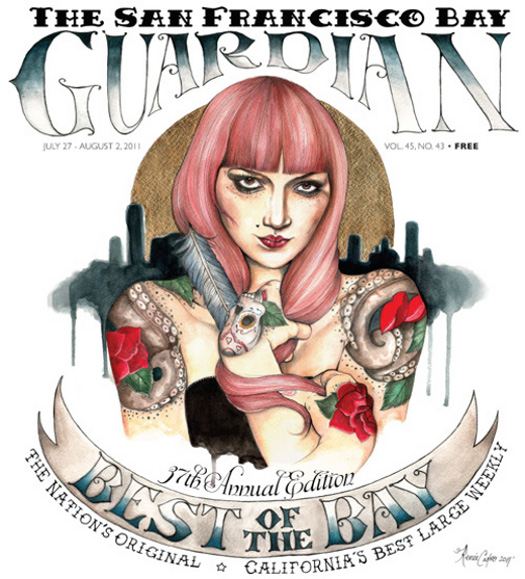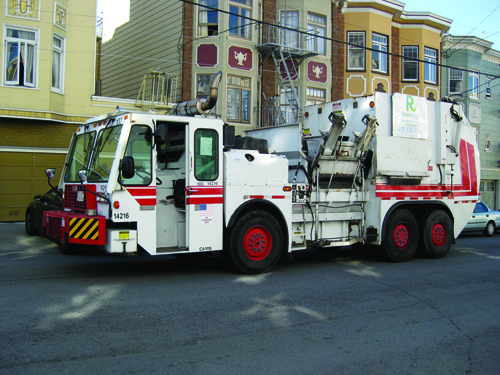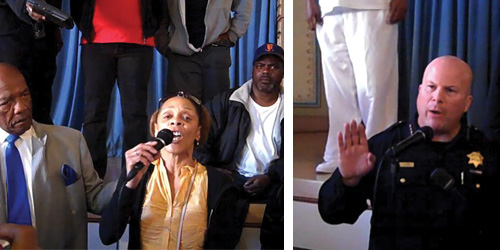Volume 45 Number 43
Perverts give good poetry
culture@sfbg.com
LUST FOR LIFE I work at the St. James Infirmary, an occupational health clinic for current and former sex workers. The clinic is a beneficiary of Dore Alley’s Up Your Alley Fair — a pride celebration for kinky people and little sister of the Folsom Street Fair — so every year I have to a work a shift at the festival. I haven’t been able to enjoy the actual street fair aspect of it for a while. But I always look forward to this week, and to Dore Alley Eve (as those of us in the kink and leather communities jokingly call it) because of Perverts Put Out (PPO), which this year takes the stage Saturday, July 30.
Now, it’s impossible for me to write about PPO without bias. I’m good friends with the producers and I’ve been on their rotating roster of performers since 2007. But I’ve also been coming to PPO as an audience member since 2004, right about the time I graduated from teen poetry slams and started performing my own works around the Bay Area.
Attending PPO for those first three years as an adult performer (in all senses of that term) and newly-minted sex writer trying to find her place in the SF spoken word scene, I received an amazing lesson in our sex and art communities. PPO is responsible for much of my education about both writing and performance. I sat back. I watched. I learned. I took a lot of notes.
So consistently well curated it borders on absurd, PPO is an impressive mix of genre and content — everything from poetry to performance art, diatribes to elegantly crafted erotic short stories. The unifying theme of PPO is of course sexuality, and most of the performers are queer in some way. But queerness and sexuality can cover a lot of ground.
Some of my favorite PPO memories from over the years: Kirk Read’s tragically beautiful piece about going duck hunting with a new lover. Daphne Gottlieb’s gorgeous poem “Carpe Nocturne” about (among other things) desire, lineage, death, and love. Lori Selke’s razor-sharp breakup letter to the racist and sexist mainstream BDSM scene. Meliza Banales’ riotously funny story about doing crystal healing sex work in Santa Cruz. Steven Schwartz’s “Bearlesque,” a smart and funny rumination on bear identity, complete with dancing and tassles. Jaime Cortez’s eerily beautiful short story “Excelsior,” about queer men cruising not in the Castro or SoMa, but in the Excelsior District. Fran Varian’s secret and brutal cop fantasy, told from the perspective of an anti-imperialist queer activist protagonist. Pretty much everything poet Horehound Stillpoint has ever done, ever. I could go on. But really, you should just come to the show.
PERVERTS PUT OUT: THE DORE ALLEY EDITION
Sat/30 7:30 p.m., $10–$15
Center for Sex and Culture
1349 Mission, SF
(415) 902-2071
BEST OF THE BAY 2011
Welcome to the Guardian’s Best of the Bay 2011! This is our 37th annual celebration of the people, places, and things that make living here such a great experience — from Best Burrito and Best Local Band to Best Strip Club, Best Shoe Store, Best Drag Queen, and beyond.
More than 15,000 of our readers voted in our 2011 Best of the Bay Readers Poll for their favorites in more than 200 categories. You’ll find the results inside — as well as 150 Editors Picks that highlight some Guardian favorites, old and new, that we think deserve special recognition for lighting up our lives this year.
Our theme for 2011 is “Beautiful Rebels” — and inside this year’s Best of the Bay, we’ve highlighted eight of our favorite “beautiful rebels” who we think are helping change the Bay Area for the better. Throughout its history, the Bay Area has attracted wave upon wave of people looking to create something unique. From Barbary Coast explorers to Belle Epoque, Jazz Age, and Beatnik free spirits, from hippies and queer and civil rights pioneers to tattooed 1990s swing kids and Burning Man visionaries, to today’s global tech innovators and their DIY, local, organic, small-batch counterparts.
We seem to be living in a time when a certain conservatism and conformity reigns, when speaking out gets you pilloried in the comments section and big-box consumerism squeezes out charming idiosyncrasies. That’s why we wanted to take this Best of the Bay opportunity to celebrate the Bay Area’s proud perseverance in remaining the weirdest, oddest, most interesting and rewarding place in the world, somewhere where “freak” is a compliment and “out there” equals “gorgeous.”
In 1974, Esquire magazine asked us for ideas for its Best of the USA issue, which led to us publish the original Best of the Bay. Made by the people of the Bay Area for the people of the Bay Area, it’s our annual opportunity to celebrate the people and places that make this city great. We were the first weekly paper to publish a regular “best of” issue. Thirty-seven years on — and 45 years after we opened our doors — we’re still going strong.
Editing this year’s installment was a hoot. I shower grateful smooches on all my collaborators, especially my right-hand amiga Caitlin Donohue, creative wiz Mirissa Neff, amazing illustrator Renee Castro, photographer Ben Hopfer, the Guardian staff, and the ever-supportive Hunky Beau, my own personal Best of the Bay.
But most of all I thank you, dear reader, for your generous participation, for making the Bay Area such an astounding place to live, and for turning us on to some great new things this year.
Marke B.,
Best of the Bay 2011 co-editor
ABOUT THE ILLUSTRATOR
Like the Guardian, Renee “Lady Reni” Castro is native to the Bay Area — really. Born in Oakland, Castro’s heritage stems from the Ohlone Native American tribe. (You can’t get more local than that.) Her background serves as inspiration for much of her art, especially her subjects’ clothing and their deeply-rooted connections to the natural world. Her other influences for her illustrations in this year’s “Beautiful Rebels”-themed Best of the Bay include Mexican and Spanish folklore, broken-hearted femmes fatales, disheveled muses, and erotic heroines. Castro’s current projects include commissions for SF companies the Loin and Peasants and Travelers, shows in local galleries, plus an apprenticeship at Amor Eterno Tattoo in Oakland, where you’re welcome to drop by and see her.
BEST OF THE BAY STAFF
BEST OF THE BAY EDITORS
Marke B., Caitlin Donohue
CREATIVE DIRECTOR
Mirissa Neff
ASSISTANT ART DIRECTOR
Ben Hopfer
ILLUSTRATOR
Renee Castro
CONTRIBUTING WRITERS
Jackie Andrews, Emily Appelbaum, Rebecca Bowe, Richard Boyce, Kimberly Chun, Angelina Cravich Cheryl Eddy, Nicole Gluckstern, Sean Hurd, Steven T. Jones, Heather Mack, Virginia Miller, Carly Nairn, Sarah Phelan, Julie Potter, Tim Redmond, Paul Reidinger, Kat Renz, Charles Russo, Amber Schadewald, Ariel Soto-Suver, Diane Sussman, Hannah Tepper, Christopher Trenchard
BEST OF THE BAY PHOTOGRAPHY
Francesca Balaguer, Stephen Heraldo, Ben Hopfer, Eric Lynch, Virginia Miller, Ariel Soto-Suver
COPY EDITORS
Emily Appelbaum, Diane Sussman
Taking out the trash
sarah@sfbg.com
A controversial city waste disposal contract appeared primed for final approval by the Board of Supervisors on July 26 (after Guardian press time) — despite being challenged by a lawsuit and initiative campaign — after two progressive supervisors rescinded their initial vote in a July 20 committee hearing and supported awarding the contract to Recology.
City staff had recommended awarding the 10-year, $112-million landfill disposal and facilitation agreement to Recology (formerly NorCal Waste Systems, Inc.), which has grown from a locally based company to the 10th largest waste management firm in the US, with $652 million in annual revenue, according to Waste Age magazine.
If the full board follows the unanimous recommendation of its Budget & Finance Committee, the vote will authorize Recology to transport and dispose up to 5 million tons of the city’s solid waste at the company’s Ostrom Road landfill in Wheatland, Yuba County. The contract will take effect when San Francisco’s disposal agreement at Waste Management Inc.’s Altamont landfill in Livermore expires — estimated to occur in 2015.
The deal will cement Recology’s control, at least for a 10-year period, over all aspects of the city’s solid waste stream, at a cost of about $225 million per year, even as the company faces significant challenges, many related to the city’s 1932 refuse collection and disposal ordinance.
That law, approved during the Great Depression to prevent conflict between competing garbage haulers, has resulted in Recology’s exercising complete control over trash collection and transportation in San Francisco, without having to bid on those contracts or pay the city franchise fees.
During the negotiations over the city’s next landfill contract — the only aspect of San Francisco’s waste stream put out to bid — this 79-year-old law was invoked to explain why Recology has the sole authority to transport trash and compostables to Wheatland, which is 130 miles from San Francisco.
The move also comes as Yuba County is contemplating significantly increasing dumping fees at the landfill — from $4.40 per ton to $20 or $30 per ton — a hike that could erase the $100 million that the Department of the Environment (DoE) claims the Recology deal would save over a competing bid by Waste Management Inc. WM is the largest waste firm in the U.S., according to Waste Age, with about $12.5 billion in annual revenues.
On July 18, WM filed a lawsuit in San Francisco Superior Court to prevent the city from approving the agreements with Recology on the grounds that they violate the city’s competitive bid laws.
“The Department of the Environment inappropriately and unlawfully expanded the scope of its 2009 ‘request for proposal for landfill disposal capacity’ and, therefore, violated the city’s competitive procurement laws,” WM alleges in the suit.
WM has long held that DoE inappropriately issued a tentative contract award for both the transportation and disposal of solid waste to Recology without soliciting any other transportation bids. But DoE, which gleans $7 million annually (to operate recycling, green building, and environmental justice programs and long-term planning for waste disposal) from rates that Recology’s customers pay, ruled last year that WM’s objections are “without merit.”
Now WM is asking the court to require DoE to scrap its award to Recology and issue a new request for proposals to comply with competitive bidding requirements.
“There is ample time for the department to issue a new RFP,” WM stated July 18, noting that there is plenty of room at its Altamont landfill to accommodate the city’s waste after the contract expires.
That same week, a coalition led by retired Judge Quentin Kopp, community activist Tony Kelly, and Waste Solutions CEO David Gavrich announced that it had submitted enough signatures to qualify an initiative on the June 2012 ballot requiring competitive bidding and franchise fees from any company that seeks to win any aspect of the city’s solid waste business.
Kelly says his group was unable to collect enough signatures in time for the November election because Recology hired the city’s two biggest signature-gathering firms to circulate what he calls a “phony petition” in support of Recology’s performance in San Francisco. And signature gatherers say they were harassed by Recology boosters while trying to petition citywide.
“But I believe the question of whether candidates support competitive bidding will continue to be a defining issue this fall,” Kelly said.
The board’s decision on the landfill agreements has already been delayed several months, following a February 2011 Budget and Legislative Analyst report recommending that the board consider submitting a proposition to the voters to repeal the 1932 refuse ordinance so that future collection and transportation services be put to bid. The report also recommended that future residential and commercial refuse collection rates be subject to board approval.
But with two progressive supervisors running in citywide elections this fall, and with Recology exerting massive pressure on elected officials, the Kelly coalition could not find four supervisors to place such a charter amendment on the November ballot, forcing them to launch their own initiative.
And at the July 20 meeting of the board’s Budget and Finance Committee, Sup. Ross Mirkarimi, who is running for sheriff, and Sup. Jane Kim rescinded their initial decision to send the agreements to the full Board without recommendation. Instead, after the committee had moved on to other business, they joined Chair Carmen Chu, one of the most conservative supervisors, in forwarding the Recology agreements to the full board with unanimous support.
Mirkarimi interrupted the committee’s next discussion to rescind the landfill vote. “I think there was some misunderstanding a little bit in wrapping up the landfill agreements with Recology, ” Mirkarimi said. He said that he asked for the vote to be rescinded, “so we can accurately reflect some of the sentiments being articulated here. I think we just learned some things on the fly.”
In many respects, the switch by Kim and Mirkarimi made sense: prior to their initial vote, they made positive statements about the proposed agreements, but also stated an interest in exploring the appropriateness of the city’s 1932 law.
“Overall, I think this was a good contract,” Kim said. But she noted that, thanks to the 1932 ordinance, the city doesn’t get franchise fees. And she claimed that it only gets half of what other Bay Area cities get from their waste contractors. “So, I’m really interested in continuing that conversation, but I think it’s a separate conversation,” she said.
Mirkarimi said it was his concerns that led the committee to “put a pause” on the Recology agreements until it could “undertake more homework.” He also noted that his office “held a number of meetings” and he tried to “leverage this opportunity to reanimate activity at the Port.”
“I was hoping that we might be able to arrive at something much more deliverable,” Mirkarimi said, presumably referring to the fact that these efforts resulted in DoE unveiling an amendment to include two “possible changes” to operations and facilities at the Port of San Francisco in the agreements.
These changes involve utilizing other modes of transportation, including barges, as alternatives to the rail-haul plan proposed in the agreement. They also call for developing new facilities at the Port for handling waste, recyclables, organics, and other refuse. The cost of such alternatives would be passed onto the rate payers.
“I think that, cost-effectively, we may be able to insert the Port into this equation, but it’s not ready for prime-time yet,” Mirkarimi said. He concluded by saying that Recology has been innovative in reducing the city’s waste stream.
“This should be a front-burner conversation,” Mirkarimi said, noting that former Mayor Gavin Newsom focused on making San Francisco “the greenest city” in the United States. He added that San Francisco claims to have a 77 percent diversion rate, the highest in the U.S., and said, “That comes at a cost, it doesn’t come for free.”
After the meeting, DoE deputy director David Assmann said that the City Attorney’s Office is reviewing WM’s filing. “But it’s too soon to comment,” Assmann said.
He also claimed that, thanks to the 1932 ordinance, “there was no practical way” for another company to transport San Francisco’s waste to its designated landfill, “other than building a second transfer station outside the city.”
But Kelly continued to express concerns that the agreements are not competitive, and that the city lacks a contract and ensuing franchise fees. “They are running this as if it’s still the 1950s,” he said.
Kelly claimed that Recology Vice President John Legnitto, who is the 2011 chair of the SF Chamber of Commerce’s Board of Directors, recently told him that Recology has been in negotiations with City Hall around a $4 million franchise fee, but that the money would now be spent opposing Kelly’s competitive bidding initiative.




